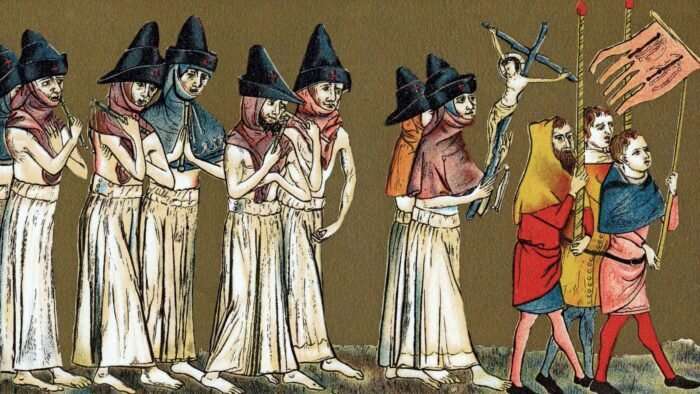Learning from echoes of past plagues, poxes, flus

Millions of people confine themselves to their homes as they battle an invisible, viral enemy. Schools and theaters close. Playgrounds empty. Medical staff choose which patients will get life-saving respirators, and which will not.
That was polio at its North American peak in the early 1950s.
Today, the worldwide COVID-19 outbreak is both familiar and concerning to Western medical historian Shelley McKellar.
She sees parallels in the current pandemic with the trajectory of history’s other fast-moving diseases, including the Black Death of the 1300s; the cholera outbreak of the 18th century; the 1918 Spanish flu epidemic; polio’s apex in the 1950s; and modern-day viruses such as HIV, SARS, MERS, H1N1 and Zika.
She cites a resiliency on two levels: On one level, the resiliency of people—we are still here and still moving forward. On the other, there’s the resiliency of the disease—we haven’t seen the end of this.
Students in her Plague, Pox and Flu: Disease in Global History undergraduate course are in the rare position of learning the historical lessons of pandemics while living in one.
“It’s a great year to teach this course,” said McKellar, the Jason A. Hannah Chair in the History of Medicine at the Schulich School of Medicine & Dentistry. “I’m so proud of my students as they’re identifying recurring themes (from history) that they see through these news stories.”
Although theories of contagion have evolved considerably over time, approaches to slowing the spread of disease hasn’t changed much. “We’ve seen similar strategies in how to address it. This is all about containment, all about barriers, all about strategic quarantine.”
Even the origin of the word quarantine stems from Italy in the 1300s, when sailors arriving on ships in Venice had to remain on board for 40 (“quaranta” ) days to as a defense against spreading the plague.
The Black Death of 1347-51, remains the most devastating pandemic in history, having killed as many as 200 million people, including half of what was then Europe’s population.
“Its incidence and mortality were so egregious,” McKellar said. It upended the labor system, changed social and economic structures, and recovery from its wide-reaching impact took as long as six generations.
Could this outbreak have such far-reaching effect? McKellar stresses her job is to examine the past—not predict the future.
In history, she tells her students, “time and place matter. The disease process is geographically contingent and culturally contingent.”
But some themes of past outbreaks do find echoes in the present pandemic, she said. One is the blame game used to further political agendas, rather than advance medical ends—a tendency that extends even to disease nomenclature.
In the 15th century, for example, Italians and Germans referred to syphilis as the ‘French disease,’ the French called it the ‘Italian disease,’ while the Dutch blamed the Spanish, and the Russians pinned it on the Poles.
Another relatively recent theme has been an increasing expectation that governments can, and should, take economic and medical measures to keep us safe.
In 1976, the H1N1 death of one U.S. serviceman at Fort Dix, New Jersey, led to fears of impact similar to Spanish flu—which killed tens of millions, more than in the Great War that preceded it. That single case prompted mass vaccinations later decried as an over-reaction—and continued today in conversations about how much government intervention is enough or too much.
One lesson of the SARS outbreak in 2003, for example, was “how crippled our preventive health measures were and how much we had taken away from those health resources,” she said. Learning from that failure has helped Canadian efforts to combat COVID-19 and emphasize that all levels of governments nationally and internationally must work together in a co-ordinated, well-communicated, measured, evidence-based response.
Pandemics also push uncomfortable ethical issues to the fore.
When polio inexplicably peaked in North America in the 1950s, medical staff had to decide who would receive breathing support in an ‘iron lung’ machine, sometimes for years, and who would be denied that chance at life.
With ‘new’ pandemics come successively different theories about their transmission: why this disease, why here, why now. “You have to understand disease-causation theories to better understand public response to disease,” she said.
If the science of the day said disease was caused by ‘bad air’, the solution was to avoid inhaling putrid smells. If people believe disease is a curse from God, they follow more religious rituals. If the medical issue is an imbalance in body fluids—the four ‘humors’ of blood, yellow bile, black bile and phlegm—then the cures include bloodletting, laxatives and emetics.
Combine those along with the ideas that disease could be transmitted by looking at a diseased person or that contagion was rooted in the alignment of the stars and planets.
Ultimately, these theories gave way by the 1880s to the germ theory of infection, which led to sanitation, antibiotics, vaccines.
Some in the mid-20th century even began positing that curing human disease was within medical/scientific reach. “We were moving on this hubris that we can live in a disease-free world—and then along comes HIV,” she said.
People shouldn’t be so surprised pandemics happen and continue to challenge us, she said.
She hopes this pandemic will teach enduring lessons useful during the next outbreak: a commitment to support health-care workers; a co-ordinated international response; individuals recognizing their responsibility to safeguard community wellbeing even if personally inconvenient; and handwashing.
Source: Read Full Article



